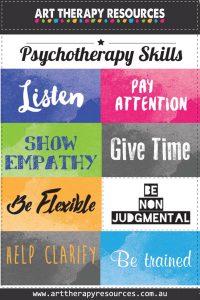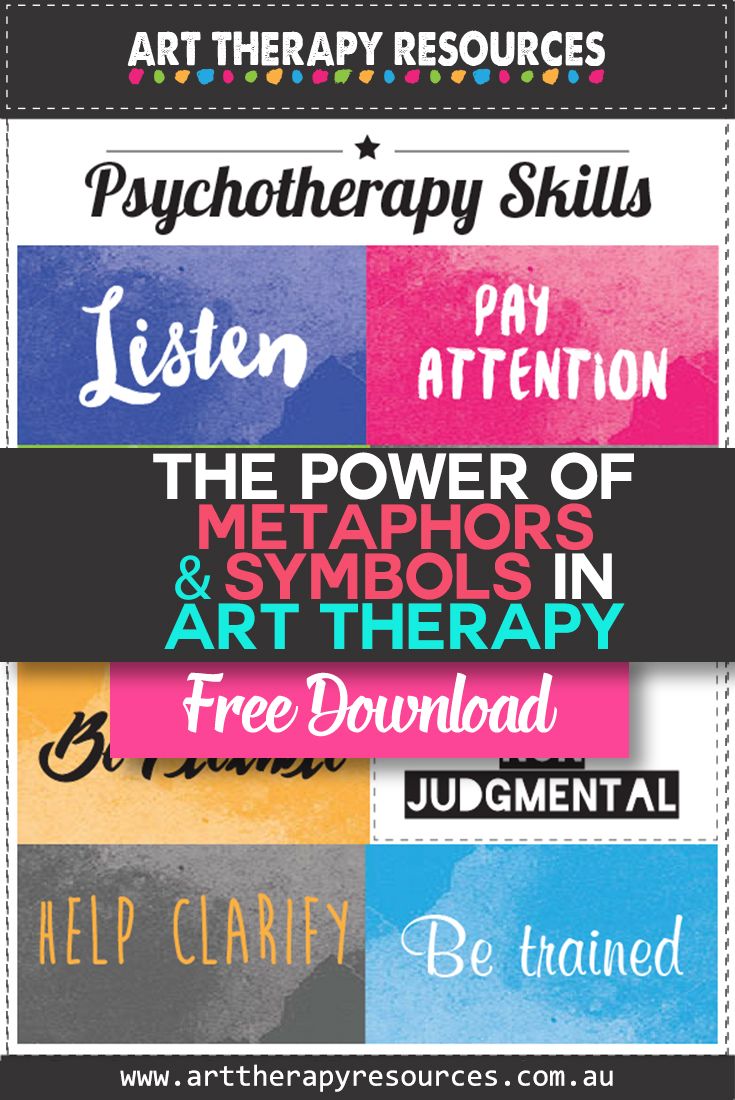THIS POST INCLUDES:
1. Art as a Language of Emotions
2. The Art of Metaphor
3. The Language of Symbols
4. Free Download Psychotherapy Skills
ART AS A LANGUAGE OF EMOTIONS
Art therapists have historically embraced psychoanalytic theory to explore the inner world of the human psyche. Psychoanalysis introduces the idea of an ‘unconscious’ intentionality that is often in competition with consciousness. Art therapy provides a unique way to work with the conscious (creative process), yet reveal the unconscious (final artwork).
Psychoanalytic theory does not hold a monopoly on understanding images solely as illustrations of the artist’s repressed inner world. Such an approach fails to appreciate the images’ emotional power, aesthetic qualities, and the context in which they were crafted.
Images created in art therapy possess layers of meaning, making them valuable for understanding a client’s state of mind. These meanings are highly personal, even when universal symbols are used. What truly matters is how these images and symbols are employed and understood.
In art therapy, the interpretation of metaphors and symbols is a collaborative process between the therapist and the client. Suggesting that an image may have meaning beyond the artist’s intention is not a substitution of one meaning with another, but instead, it can be an addition of meaning.
Psychoanalysis is deeply embedded in the art therapy landscape. It provides a ready-made language for therapists to think about and articulate their work. However, there is a distinction between art therapy and psychoanalysis. Art therapists emphasize the integration of psychoanalytic ideas into clinical practice rather than allowing them to dictate the art therapy process. While psychoanalysis offers invaluable tools, it raises crucial questions about avoiding reductive interpretations.
Art therapy is based on the belief that not all aspects of our inner world can be adequately expressed through words alone. There are states of mind, emotions, and experiences that transcend the limitations of verbal language. Two essential forms of symbolic expression are particularly pertinent in art therapy: metaphor and symbol formation.
THE ART OF METAPHOR
Metaphors allows us to draw parallels between seemingly unrelated elements. A metaphor, in its simplest form, is a figure of speech that implies that the qualities of one thing are similar to those of something entirely different. It’s a bridge between the familiar and the abstract, a tool that enriches our ability to express the inexpressible.
In a metaphor, the comparison is implied. While metaphors often take centre stage in the world of language, they have a visual counterpart: visual metaphors. These powerful tools use imagery to evoke ideas, emotions, and connections beyond the physical objects they represent.
Metaphors are so ingrained in our lives that we often take them for granted. Examples include expressions such as being “buried under a mountain of work” or claiming we’re about to “boil over.” Our everyday language is peppered with these linguistic devices that colour our conversations and influence how we think, feel, and communicate with others.
Metaphors aren’t confined to everyday language. They’re interwoven into the fabric of psychoanalytic theory. Furthermore, art therapy offers a unique canvas for the exploration of metaphors by encouraging clients to bring these symbolic expressions to life through art. In the art therapy setting, visual metaphors emerge spontaneously or intentionally as clients create images that represent their emotions and experiences. These images transcend the need for verbal expression, delving into the heart of what cannot be easily put into words.
Metaphors, whether in words or visuals, can be either “framed” or “unframed.” A framed metaphor is open to interpretation, inviting exploration with phrases like “as if.” In contrast, an unframed metaphor is more cryptic and hidden, existing just below the surface of consciousness. Art therapists are adept at identifying these unframed metaphors and helping clients translate them into framed ones.
THE LANGUAGE OF SYMBOLS
Individuals use symbols to represent their thoughts, emotions, and experiences. While psychoanalysis relies heavily on words to delve into the human psyche, art therapy harnesses the power of images to give voice to the ineffable.
In art therapy, symbol formation is a powerful tool for expression. Clients often create symbols within their artwork that represent intricate emotions, complex relationships, or even deeply buried memories. Deciphering these symbols is a bit like deciphering a universal code of the human psyche. While the specific interpretation of symbols can be highly personal, some universal symbols have shared meanings, making the process of understanding art more accessible.
An art therapist can work with their client to delve into the emotional resonance of the client’s artwork and give meaning to the symbols used by the client. In this sense, the art therapist can act as a facilitator to ‘decode’ symbolic expression and provide a bridge between images and verbal interpretation.
Symbols, much like metaphors, serve as bridges between the known and the abstract. They connect one thing with something else, reaching into the deeper realms of the human psyche. While metaphors provide a single comparison, symbols can hold a multitude of meanings. This ambiguity is what makes symbols so potent.
In art therapy, symbols are like puzzle pieces waiting to be solved. The images created by clients may not reveal their true meaning immediately; sometimes, they need time to unravel. This underscores the importance of patience and restraint for art therapists. Jumping to conclusions too soon can lead to misunderstandings and misinterpretations.
A symbol’s meaning depends on the context in which it is created and used. For example, a drawing of a house could represent a physical place or serve as a symbol of one’s self. Additionally, clients may use the same symbol to express completely different emotions that are contained or trapped as represented by the house. The meaning attached to the house is always relevant to the individual who uses the symbol in their art making.
Clients may merge public and private symbols. Colours, materials, and objects might carry public or universally understood meanings alongside personal associations. The colour red could symbolize anger or passion, but it may also hold more personal significance.
Symbols are inherently ambiguous, with meanings that can be explicit or hidden, conscious or unconscious. When working with a client’s images in art therapy, therapists must navigate this ambiguity and work with the client to explore the multiple meanings contained within.
Understanding the use of symbols can sometimes feel like an elaborate game of hide and seek or a complex code to decipher. Clients may provide explicit invitations to decode their images, but, like the skilled detective who sometimes misses the obvious clues, art therapists must tread carefully as misinterpretations can occur when the process is not entirely client based. In this context, personal bias or relying on previous therapeutic experiences can influence the art therapists view of the meaning behind a symbol presented in an artwork.
Symbols in art therapy are like cryptic messages waiting to be decoded. Just as in life, they don’t always reveal their secrets right away. Instead, they encourage patience and exploration.
FREE DOWNLOAD
SIGN UP below to gain access to our RESOURCE LIBRARY and download the FREE Psychotherapy Skills handout.

BUILD YOUR ART THERAPY REFERENCE MATERIALS:
Pin this image to your Pinterest board.

SHARE KNOWLEDGE & PASS IT ON:
If you’ve enjoyed this post, please share it on Facebook, Twitter, Pinterest. Thank you!
